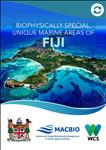Title
Biophysically Special, Unique Marine Areas of Fiji
Author(s)
Sykes, H.;Le Grand, J.;Davey, K. ;Kirmani, S. N.;Mangubhai, S.;Yakub, N.;Wendt, H.;Gauna, M.;Fernandes, L.
Published
2018
Abstract
Fiji is committed to, and is embarking upon, a process to significantly increase the number and coverage of Marine Protected Areas (MPAs) within the country.
To help deliver on this commitment, the Marine Working Group of the Fiji national Protected Area Committee (PAC), established under the Environmental Management Act 2005, requested a review of previous efforts to describe marine priority sites for Fiji. To this end, the then Department of Environment (now Ministry of Environment) and the then Ministry of Fisheries and Forests (now Ministry of Fisheries) convened an expert workshop on the 19th and 20th July 2016. The Marine and Coastal Biodiversity Management in Pacific Island Countries (MACBIO) Project1 and the Wildlife Conservation Society (WCS) supported the workshop.
The objectives of the workshop were to review previous efforts to identify marine priority sites and prepare a report, with maps, identifying updated Special, Unique Marine Areas (SUMAs) for Fiji.
Prior to the workshop, participants were provided with a range of resource material including, reports and maps from the earlier prioritisation studies. During the workshop additional information was made available, largely maps and GIS with new biophysical, spatial data. On the first day, participants were spilt into regional groups to review, amend and, in some cases, add new site descriptions to the earlier work.
On the second day, participants were asked to rate each site based on the following criteria:
■ Amount, detail, and nature of biological justification
■ Geographic explicitness
■ Information sources
■ National or international obligations
A technical expert, who participated in the workshop, and who was familiar with a range of marine environments across the Fiji Islands was engaged to review and compile the information gathered at the expert workshop. Post workshop research was also conducted, through one-on-one interviews and additional mini-workshops. This information, together with the workshop has been almagamated into this report. In total, 98 inshore and offshore Special, Unique Marine Areas (SUMAs) were identified.
Site scores range from as low as 5 to as high as 12 (highest possible score). Both high and low scores are useful for management; high-scoring sites can be prioritised with confidence, while lower-scoring sites can be highlighted for needing more research or requiring protection for the purposes of ecosystem recovery, or even restoration efforts. Future scoring systems may take into account levels of human use or impact, as this affects the intrinsic ecological value of a habitat, assemblage, population or ecosystem. The identification and scoring of special, unique marine areas can guide the next steps in creating a network of marine protected areas, future marine spatial planning, and also inform other management measures (e.g. permit or licencing decisions) or environmental impact assessments (EIAs) that may be
relevant to these locations.
Full Citation
Sykes, H.;Le Grand, J.;Davey, K. ;Kirmani, S. N.;Mangubhai, S.;Yakub, N.;Wendt, H.;Gauna, M.;Fernandes, L. (2018). Biophysically special, unique marine areas of Fiji. Suva, Fiji: MACBIO (GIZ/IUCN/SPREP), Wildlife Conservation Society, Fiji, and Fiji's Protected Area Committee.
Access Full Text

Back
DMX4067900000